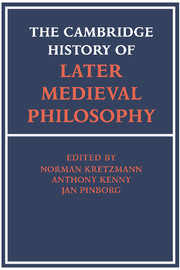 The Cambridge History of Later Medieval Philosophy
The Cambridge History of Later Medieval Philosophy from XI - The defeat, neglect, and revival of scholasticism
Published online by Cambridge University Press: 28 March 2008
Spain as the bastion of late scholasticism
After the attacks of humanists, Ramists, reformers, and plain haters of philosophy over much of two centuries, it is amazing that scholasticism survived at all. Not only did it survive, it experienced a notable revival throughout much of western Europe towards the end of the sixteenth century and beginning of the seventeenth. Humanists and reformers were by no means unanimous in opposing the medieval scholastics. More important, the Iberian peninsula was comparatively unaffected by the intellectual and religious ferment of most of the rest of Europe. The schools of Spain and Portugal had a more or less continuous tradition of scholastic philosophy, and the leading figures in the general revival of scholastic thought round the end of the sixteenth century tend to be Spaniards like Bañiez, Vásquez, and Suárez. In northern Europe the scholastic revival looks more like a self-conscious and deliberate Aristotelian reaction to Ramists, humanists, and the like, but the northerners of whatever religious allegiance were happy enough to take guidance and inspiration from Spain.
New trends in late scholasticism
Although in obvious ways continuous with the main medieval tradition, late scholasticism, whether in its Iberian form or in its northern revival, shows certain very distinctive characteristics of its own which may be seen as marking a transition to some of the most prominent themes of early modern philosophy.
While these philosophers were nearly unanimous in rejecting medieval nominalism (indeed, in the north this was another of the things they were reacting against), Scotus, Ockham, and the later nominalistic tradition had a very powerful influence on them.
To save this book to your Kindle, first ensure [email protected] is added to your Approved Personal Document E-mail List under your Personal Document Settings on the Manage Your Content and Devices page of your Amazon account. Then enter the ‘name’ part of your Kindle email address below. Find out more about saving to your Kindle.
Note you can select to save to either the @free.kindle.com or @kindle.com variations. ‘@free.kindle.com’ emails are free but can only be saved to your device when it is connected to wi-fi. ‘@kindle.com’ emails can be delivered even when you are not connected to wi-fi, but note that service fees apply.
Find out more about the Kindle Personal Document Service.
To save content items to your account, please confirm that you agree to abide by our usage policies. If this is the first time you use this feature, you will be asked to authorise Cambridge Core to connect with your account. Find out more about saving content to Dropbox.
To save content items to your account, please confirm that you agree to abide by our usage policies. If this is the first time you use this feature, you will be asked to authorise Cambridge Core to connect with your account. Find out more about saving content to Google Drive.